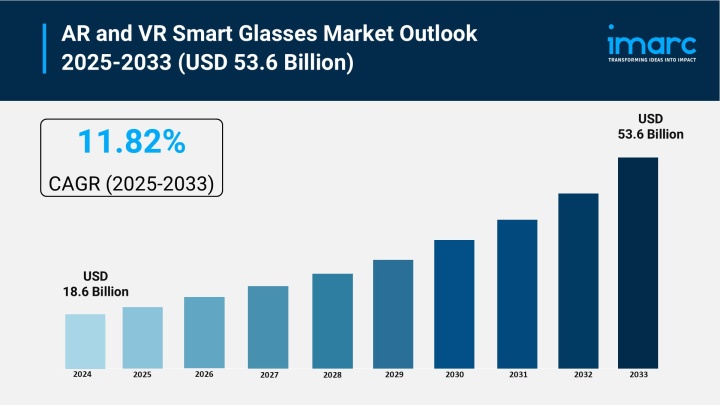

Market Overview:
The AR and VR Smart Glasses Market is experiencing rapid expansion, driven by Rapid Technological Advancements, Increasing Product Adoption in Various Industries and Growing Consumer Interest. According to IMARC Group's latest research publication, "AR and VR Smart Glasses Market: Global Industry Trends, Share, Size, Growth, Opportunity and Forecast 2025-2033", The global AR and VR smart glasses market size reached USD 18.6 Billion in 2024. Looking forward, IMARC Group expects the market to reach USD 53.6 Billion by 2033, exhibiting a growth rate (CAGR) of 11.82% during 2025-2033.
This detailed analysis primarily encompasses industry size, business trends, market share, key growth factors, and regional forecasts. The report offers a comprehensive overview and integrates research findings, market assessments, and data from different sources. It also includes pivotal market dynamics like drivers and challenges, while also highlighting growth opportunities, financial insights, technological improvements, emerging trends, and innovations. Besides this, the report provides regional market evaluation, along with a competitive landscape analysis.
Download a sample PDF of this report: https://www.imarcgroup.com/ar-vr-smart-glasses-market/requestsample
Our Report Includes:
Growth Factors in the AR and VR Smart Glasses Industry:
AR and VR smart glasses are undergoing a wave of innovation as companies race to enhance usability and immersion. AI-powered features like real-time language translation, adaptive user interfaces, and intelligent scene recognition are transforming the user experience. Battery efficiency improvements and ultra-thin form factors are making devices more lightweight and stylish. Integration with edge computing and cloud services is enabling faster rendering and reduced latency for enterprise applications. Meanwhile, advancements in holographic projection and retinal display technology are pushing visual quality to new heights. These technological leaps are establishing AR and VR smart glasses as essential tools for next-gen communication.
The scope of AR and VR smart glasses adoption is widening as more industries recognize their strategic value. Manufacturing plants deploy them for hands-free assembly guidance and predictive maintenance checks, reducing errors and downtime. In real estate, virtual property tours through smart glasses are transforming client engagement. Airlines are experimenting with AR overlays to assist cabin crew with passenger needs in real time. In healthcare, beyond surgeries, glasses are supporting rehabilitation therapies and patient education. Even the retail sector benefits, with employees accessing real-time inventory and customer preferences. This multi-sector adoption reflects the technology’s expanding role in boosting efficiency and creativity.
Consumers are increasingly embracing AR and VR smart glasses as part of their daily digital lives. Entertainment companies are introducing interactive movie experiences, where audiences view alternate storylines through immersive glasses. Fitness brands are blending real-world workouts with gamified AR landscapes to boost motivation. Social connectivity is another driver, with platforms enabling shared AR experiences like virtual concerts or collaborative projects. Early adopters are also experimenting with navigation-enhanced smart glasses that provide walking or driving directions directly in the field of view. With consumers valuing both practicality and novelty, AR and VR glasses are poised to become mainstream lifestyle gadgets.
Key Trends in the AR and VR Smart Glasses Market
Optical see-through glasses are emerging as the go-to format for balancing immersion and real-world visibility. These devices provide workers with context-sensitive instructions without blocking physical tasks, making them invaluable in assembly lines and field service. Retailers use them to display customer purchase histories and personalized promotions in real time. Enhanced contrast, wider viewing angles, and adaptive brightness modes are improving comfort for extended wear. Researchers are also integrating biometric sensors into optical lenses, enabling health monitoring during industrial tasks. By offering a blend of safety, efficiency, and seamless digital integration, optical see-through technology is becoming the backbone of enterprise AR.
The gaming sector remains a cornerstone for AR and VR smart glasses growth, continuously driving innovation. Developers are designing open-world titles where AR glasses overlay quests, characters, and rewards in real environments, blurring the line between physical and digital play. Multiplayer VR ecosystems are creating social gaming hubs, boosting community engagement. Hardware makers are pairing glasses with tactile gloves and motion sensors to heighten realism. Subscription-based cloud gaming services are making immersive experiences more accessible without heavy hardware investment. With the rise of cross-platform gaming, AR and VR glasses are not just accessories but essential devices shaping the future of interactive entertainment.
North America leads the global AR and VR smart glasses market due to its strong tech ecosystem and early adoption culture. Enterprises in sectors like logistics and energy are piloting smart glasses to train workers in hazardous environments safely. Universities are deploying AR-enabled labs for remote science experiments, expanding accessibility. Government programs supporting digital equity are funding AR-based education for underserved communities. In retail, major brands are experimenting with augmented shopping experiences to boost consumer engagement. Coupled with a mature 5G network and an innovation-driven workforce, North America’s dominance is anchored in its ability to merge research, investment, and rapid deployment.
Leading Companies Operating in the Global AR and VR Smart Glasses Industry:
AR and VR Smart Glasses Market Report Segmentation:
Breakup by Type:
Optical see through accounts for the majority of the market share due to advanced technology allowing simultaneous viewing of real and virtual environments.
Breakup by End Use:
Gaming industry holds the largest share of the industry due to high demand for immersive and interactive gaming experiences.
Breakup by Region:
North America leads the market, accounting for the largest AR and VR smart glasses market share due to strong technological infrastructure and high consumer adoption rates.
Note: If you require specific details, data, or insights that are not currently included in the scope of this report, we are happy to accommodate your request. As part of our customization service, we will gather and provide the additional information you need, tailored to your specific requirements. Please let us know your exact needs, and we will ensure the report is updated accordingly to meet your expectations.
About Us:
IMARC Group is a global management consulting firm that helps the world’s most ambitious changemakers to create a lasting impact. The company provide a comprehensive suite of market entry and expansion services. IMARC offerings include thorough market assessment, feasibility studies, company incorporation assistance, factory setup support, regulatory approvals and licensing navigation, branding, marketing and sales strategies, competitive landscape and benchmarking analyses, pricing and cost research, and procurement research.
Contact Us:
IMARC Group
134 N 4th St. Brooklyn, NY 11249, USA
Email: sales@imarcgroup.com
Tel No:(D) +91 120 433 0800
United States: +1–201971–6302
